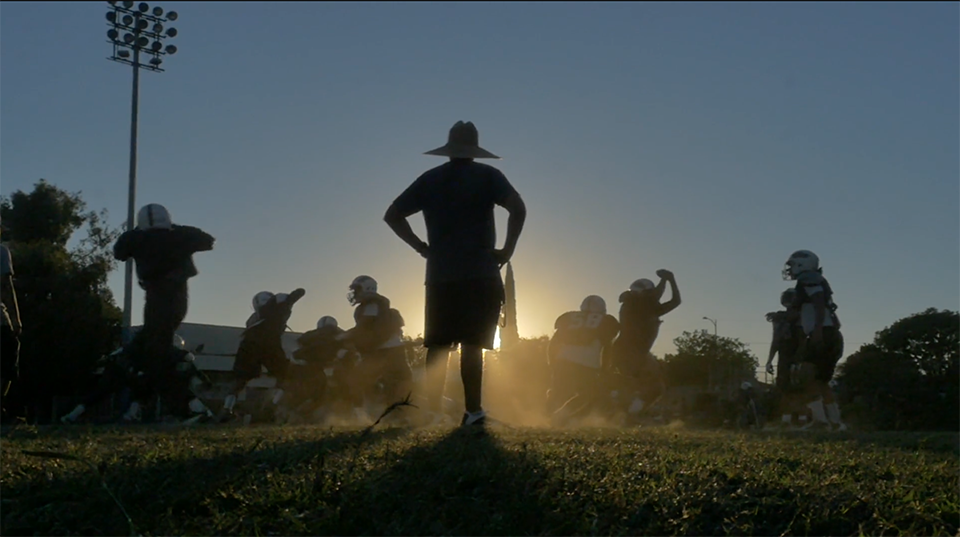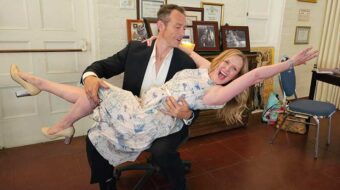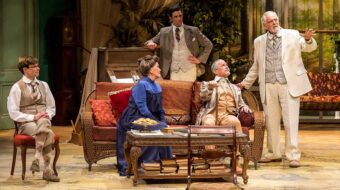
You might be shocked to learn that I care nothing about football; in fact, nothing about any organized sport, especially as commercial as it has become. If anything, my feelings are overall more negative than positive. I worry about the exploitation of the public, the fans who in their craze to support the hometown team practically bankrupt themselves on tickets, hot dogs and beer, and commit acts of verbal and physical violence against opposing fans. And are these truly hometown teams any more? To me they seem mere investments owned by corporate conglomerates, with athletes traded like futures on Wall Street. In the particular cases of football and boxing I’m concerned for the players’ mental health in the years to come after all that pummeling, the concussions and brain damage.
But I was interested in this film, receiving its world premiere recently at the Los Angeles Film Festival 2017, for the same reason the filmmaker made it. He heard about it casually one day on the radio and never knew, as I didn’t, about “The Classic,” this distinctly American event that takes place every November, an annual expression of the fierce high school football rivalry between Theodore Roosevelt and James A. Garfield High Schools in East Los Angeles, less than five miles apart, that attracts over 25,000 enthusiasts. I felt I was missing a significant part of the lives of my fellow Angelenos—though I can’t say I ever attended a football game at my own high school either.
As written, directed and edited by Billy McMillin in his feature directorial debut, The Classic is about much more than football. At core, it’s really about what it means to be an American. This sport is for all practical purposes not played anywhere but the U.S. and Canada, but L.A. has the largest Latino immigrant population in the U.S., and these two high schools are almost 100 percent populated by immigrants or children of immigrant families.
East L.A. is known as “the Ellis Island of the West,” the area east of downtown that has housed many previous generations of immigrants—Russian, Jewish, Japanese, Mexican, and now also from other Central American countries. The Classic was played then, too, and had the same meaning it still has: Acculturation, adaptation, affirmation of the American way of life—both schools are named for U.S. presidents. (Garfield was made famous by the film Stand and Deliver about the teacher Jaime Escalante.) Only problem is, in those times racism kept just about anyone who wasn’t white off the team. It was a big thing when the first Latinos started competing in the game. There had never been a black player until now.
As McMillin has written, “With the rise of Trump and his proposed border wall becoming a divisive symbol in public discourse, I knew this story was more urgent than ever.… it’s about East L.A. and how this unique community fits into the America of today. Not in a static way, but like all immigrant communities before them, in a way that is complex, evolving, growing, and changing the country.”
As I sat down to this 97-minute film, I thought to myself, “I’ve seen this before,” but of course, no, I hadn’t. It’s just that it does follow a familiar arc—establish the setting, highlight the importance of the game, the lead-up training and preparation, some intense closeups on a few of the players, The Game itself, and the epilogue—the format reality shows follow religiously.
McMillin focuses on the lives of six protagonists to humanize the story for us. The first of the two opposing coaches is Javier Cid, head coach of the Roosevelt Rough Riders for 14 years who once played on the team himself, and likely would have dropped out were it not for football. Also a history teacher, he is proud of the 100% graduation rate for his players. He makes a point of recruiting exclusively East L.A. locals for his team.
Lorenzo Hernandez, the Garfield Bulldogs coach, is a cop by day, but his philosophy is a little different: He does recruit from outside his district. Since he began doing so five years ago, he has not lost a single game against Roosevelt. Message being, a little diversity helps. In fact, this year he has gone all the way down to South L.A. to recruit Stevie Williams, the first African American to ever play in The Classic. He works hard to earn his stripes.
The other Garfield player we get to know is Joseph Silva, who comes from a troubled family. Maybe for that reason he’s become an aggressive player given to physically injuring others on the field. At 16 he fathered a daughter, and the mother is still very much in the picture. He seems a devoted parent who lives for the next generation’s happiness. He works a job in the bakery run by Homeboy Industries, side-by-side with parolees and former gang members.
And playing for Roosevelt we have Sammy Hernandez, coach Lorenzo’s son. Among the Latino kids, he is probably the most assimilated, as he only knows a few words of Spanish and he begins to worry that he’s losing touch with his Mexican roots. The only quality time he spends with his dad is on the field. He has a lot to live up to.
Mario Ramirez, with his 3.9 GPA, is applying to Yale, Princeton and Harvard, eager to be the first person in his family to graduate from college. His parents speak no English. Their small, three-bedroom house has 14 people living in it, all extended family members, some U.S. citizens and some not. He has an undocumented girlfriend “Yellow,” who appears unafraid to be seen on the big screen (a few group shots elsewhere in the film have blurred-out faces).
The cinematography is lively with all the movement of the sport, the cheerleaders, the bands, the crowd, and touchingly intimate in home and workplace scenes with the featured players. An epilogue brings us up to date on what happens with these characters in the aftermath of this vital rite of passage. They’ve learned some life lessons they will never forget. As Coach says, “You have to adjust to the things that come at you.”
The trailer can be seen here.












Comments